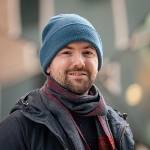Internship results in a job offer
One of his fellow students, Norwegian native Nora Margrete Marsteen, came to the master’s programme directly from the bachelor's programme.
“I chose the master's in product design at OsloMet because it includes an internship in the private or public sector built into the programme,” Nora explains.
“As I recently started applying for jobs, I have noticed that work experience is often required in addition to a master's degree.”
In the spring of 2020, just before Norway shut down as a result of the pandemic, Nora began her internship with the City of Oslo.
After the internship was over, she was offered a job for the summer, and then a part-time position where she works with service design for one of Oslo’s city districts.

The internship lead to a great job opportunity for Nora Margrete Marsteen, and she has already started working with service design. Photo: Per Christian Lind
“I am now collaborating with one of my classmates on a master's thesis who also had an internship with the City of Oslo."
"The subject of the thesis is how the district where we’re interning can improve its outdoor areas so that people will use them more. Our master's may be called product design,” Nora notes, “but we learn a lot about service design too.”
While the bachelor's programme focuses on practical skills, knowledge of materials and the design process, the master's program provides an in-depth study of the theories behind the design process.
“When I finished the bachelor’s programme, I found myself wanting more theoretical knowledge,” says Nora.
In the master’s programme, we learn a lot about psychology and how design affects people. Learning about these things is fascinating.
– Nora Margrete Marsteen
Shifting focus from furniture to service design
Another current MA student, Nadiya Karibayeva of Kazakhstan, came to OsloMet thinking a master’s in product design would allow her to create furniture in the future.
When she arrived in Norway, Nadiya already had a bachelor's degree in architecture from the University of Manchester.
But Nadiya soon realized that working on large-scale projects was not the right thing for her. She wanted to work with design in a different way.

In Oslo urban life and nature go hand in hand. Photo: Benjamin A. Ward / OsloMet
“I had been thinking about pursuing a master's degree abroad for a while. I knew I wanted it to be something related to design, but I didn’t know exactly what."
"When I saw a BBC documentary about design, it dawned on me what I wanted to do: solve problems small and large and help make people's lives better,” Nadiya reflects.
“I did not want to be a passive spectator.”
Small class size is another reason Nadia chose OsloMet—there are only 14 students in the programme.
Nadiya had also heard good things about the workshops and the impressive machine park where students can work with a variety of materials.

Having finished the master’s degree in product design, Nadiya Karibayeva is looking forward to focusing on service design in her future career. Photo: Private
At the Department of Product Design, each student gets a personal workspace and can try everything from text printing to 3D printing of clay, as well as a whole range of digital tools.
Nadiya no longer dreams of designing sofas, tables and chairs in a future career. Instead, she has fallen in love with service design.
“I’m particularly interested in social design. Public services, social innovation and health are all fields I would like to explore and contribute to. After the two years spent at OsloMet, I feel prepared to go out and do this.”

Students from many countries participate in the master's programme in product design at OsloMet, and all lectures are held in English. Photo: Private












